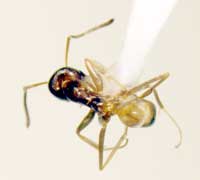Characteristics:
- 1/8 inch body length (monomorphic)
- Pyramid-shaped projection on top of the thorax
- Antennae have 12 segments without a defined club
- Color combinations:
- Reddish-black head and thorax – black abdomen
- Red head and thorax – black abdomen
The colonies are usually small, with a single queen, consisting of a few hundred to a few thousand individuals. Nests are usually constructed in open areas, free of vegetation. Excavated soil is deposited around the entry hole and forms a circular crater. Pyramid ants often nest near the nests of other ants. It is often found nesting in the cleared nest surface of harvester ants. New colonies are formed by nuptial flights of winged reproductives that swarm in the summer. Little is known of the life history of this ant.
Distribution
The pyramid ant, Dorymyrmex pyramicus (Roger), is widely distributed over the United States, but is probably more common in the south. It also occurs in Mexico, South America, and the West Indies. Pyramid ants construct their nests in bare soil in open, sunny areas.
Management
Pyramid ant colonies are small and nesting chambers are formed just below the surface of the soil, providing easy access to the entire colony. Individual colonies can be treated by injecting an appropriate insecticide directly into the entrance hole using a compressed air sprayer. The use of a crack and crevice tip fitted on the spray nozzle should be inserted directly into the entrance hole. Two or three ounces are needed to treat each colony. Colonies found under items on the ground can be drenched with a few ounces of insecticide. Baits containing a sweet attractant can be effective in areas where workers are active but the colony cannot be located